,,,
目前,对于自身血管条件差、无法建立自体或移植动静脉内瘘的血液透析病人将中心静脉导管(central venous catheters,CVC)作为其血管通路的比例越来越高[1],有25%~50%的病人在CVC置入1年内就会发生导管功能失用[2];此外,CVC的置入与病人抗生素耐药的发生、住院时间延长、医疗成本增加及其死亡率密切相关[3],这可能是与CVC导管功能障碍(catheter malfunction,CM)、导管相关感染,尤其是导管相关血流感染(catheter-related bloodstream infection,CRBI)的发生有关。美国CRBI的发生使病人平均住院日延长5 d~20 d,花费高达8 000~50 000美金[4],因此,在每次透析治疗结束后,使用抗凝剂进行封管保持导管通畅,预防血栓形成,避免透析间期发生感染是目前公认的做法。已有研究证实,肝素封管与非肝素封管相比,可明显降低导管阻塞、CRBI和导管微生物定植的发生风险[5-6]。但有研究发现,封管肝素从管腔内溢出会增加病人全身抗凝的危险性[1]。因此,探寻一种替代肝素封管的方式势在必行。有研究探讨使用枸橼酸盐封管在改善导管通畅性,减少CM发生方面的作用,结果显示,使用枸橼酸盐封管可降低病人出血和CRBI的发生率[7-8],但在维持导管通畅性方面,枸橼酸盐封管和肝素封管的作用则没有显着差异。但也有学者研究发现,枸橼酸盐联合抗生素封管可降低CRBI发生率及拔管率[9-10],而单纯枸橼酸盐封管则无此疗效。事实上,没有一种封管方式可以同时降低CRBI和CM的发生率,因此,本研究拟通过Meta分析探索抗凝剂(肝素、枸橼酸盐)联合或不联合抗生素对血液透析病人CVC置管封管,在预防CRBI、出血等方面的作用。
1 资料与方法
1.1 纳入标准和排除标准
1.1.1 纳入标准
研究为前瞻性随机对照试验(RCT);对照组为单纯肝素封管,试验组为肝素联合抗生素封管或肝素/其他抗凝剂联合/不联合抗生素;计算风险比率(RR)和95%置信区间(confidence interval,CI);随访时间大于30 d。
1.1.2 排除标准
CVC置管不用于血液透析;研究为回顾性研究或动物实验、体外试验。
1.2 检索策略
2名研究者分别以“血液透析”“抗凝”和“导管”作为主题词,检索发表于Medline、EMbase、PubMed数据库的研究。不限定发表时间,语言限定为英文。
1.3 结局指标
主要评价指标为CRBI发生率;次要评价指标为出血、导管出口感染(ESI)发生率。
1.4 数据提取
2名研究者分别独立评估每项研究并记录文献质量及其纳入、排除标准。数据提取内容包括病人基线水平、干预方式、病人数量、导管留置天数、随访时间以及其他可能影响研究结果的干预措施,并以Cochrane质量评价标准对文献进行评估[11]。
1.5 统计学方法
采用Review Manger 5.0软件进行统计分析,对照组和试验组的二分类变量和连续变量分别采用RR和95%置信区间(confidence intenal,CI)的加权平均差表示。考虑到研究中固有的异质性,假设存在统计异质性,并使用随机效应模型合并数据。测量结果的异质性使用Q检验,量化异质性用I2表示[11]。使用亚组分析探索异质性来源,并评估结果的灵敏度;使用漏斗图检测发表偏倚;以P<0.05为差异有统计学意义。
2 结果
2.1 文献检索结果
文献检索共检索到224篇相关研究,经筛选共纳入17项研究[8,10,12-26]进行系统综述和Meta分析。文献检索流程图见图1。
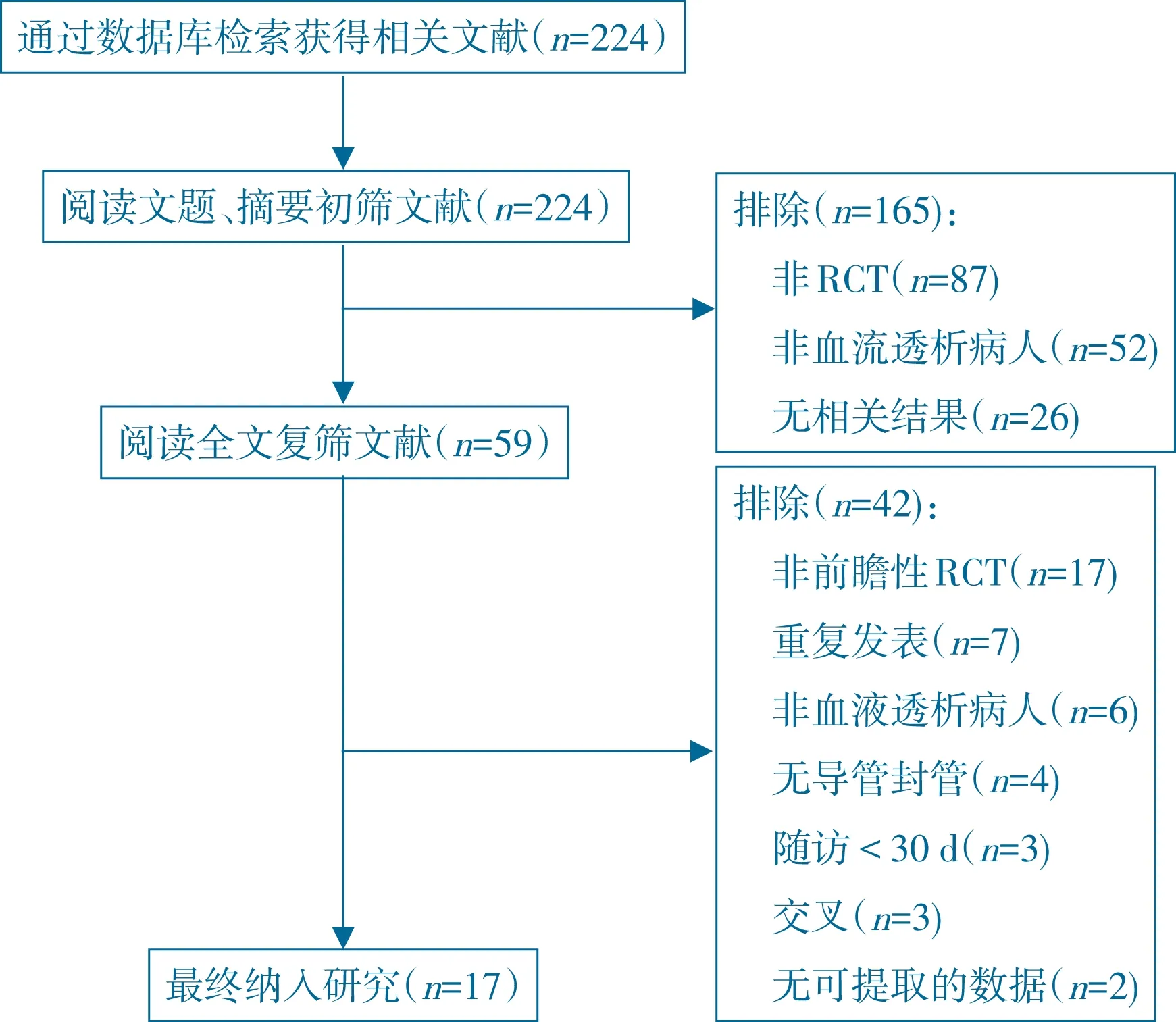
图1 文献检索流程图
2.2 纳入研究的基本特征
共纳入17项研究[8,10,12-26]中所有研究的对照组均为单纯肝素封管。纳入研究的基本特征见表1,纳入研究的方法学质量评价见表2。
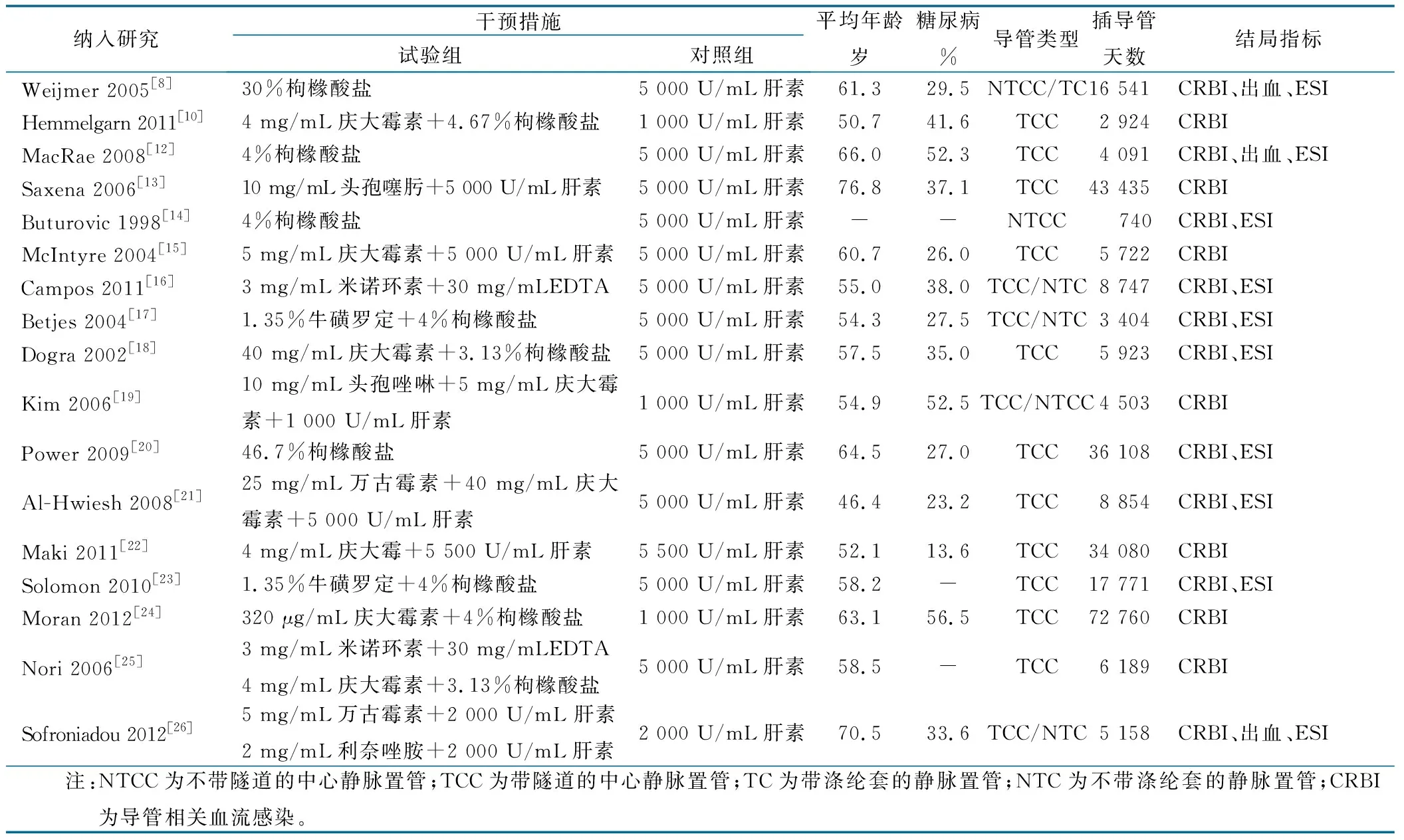
表1 纳入研究的基本特征

表2 纳入研究的方法学质量评价
2.3 结果分析
2.3.1 CRBI
所有研究[8,10,12-26]均报道了CRBI的发生率,与单纯肝素封管相比,联合抗生素封管可显着降低CRBI的发生率[OR=0.36,95%CI(0.28,0.46),P<0.001],见图1。
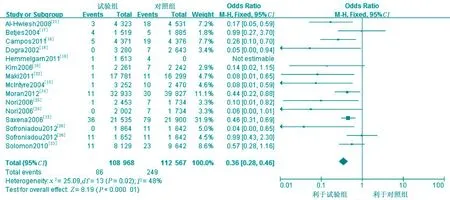
图1 CRBI发生率的Meta分析
2.3.2 出血
3项RCT研究[8,12,26]评价了出血的发生率。单纯枸橼酸盐封管的病人,每个导管日任何类型出血的发生率均低于肝素封管的病人[OR=0.46,95%CI(0.30,0.72),P<0.001],异质性在可接受范围,见图2。但无证据表明,联合抗生素封管可以降低出血事件的发生率,见图3。

图2 出血发生率的Meta分析

图3 出血发生率的Meta分析
2.3.3 ESI发生率
10项RCT研究[8,12,14,16-18,20-21,23,26]描述了ESI的发生率,采用固定效应模型进行分析,单纯枸橼酸封管与肝素封管相比,[OR=0.54,95%CI(0.34,0.85),P=0.007];根据导管类型进行进一步亚组分析,NTCC组间OR值有显着差异[OR=0.28,95%CI(0.12,0.68),P=0.005],TCC组间OR值无显着差异[OR=0.73,95%CI(0.42,1.27),P=0.26]。由此可见,导管类型是异质性的来源,见图4。联合抗生素封管与单纯肝素封管在降低ESI方面无显着差异,见图5。
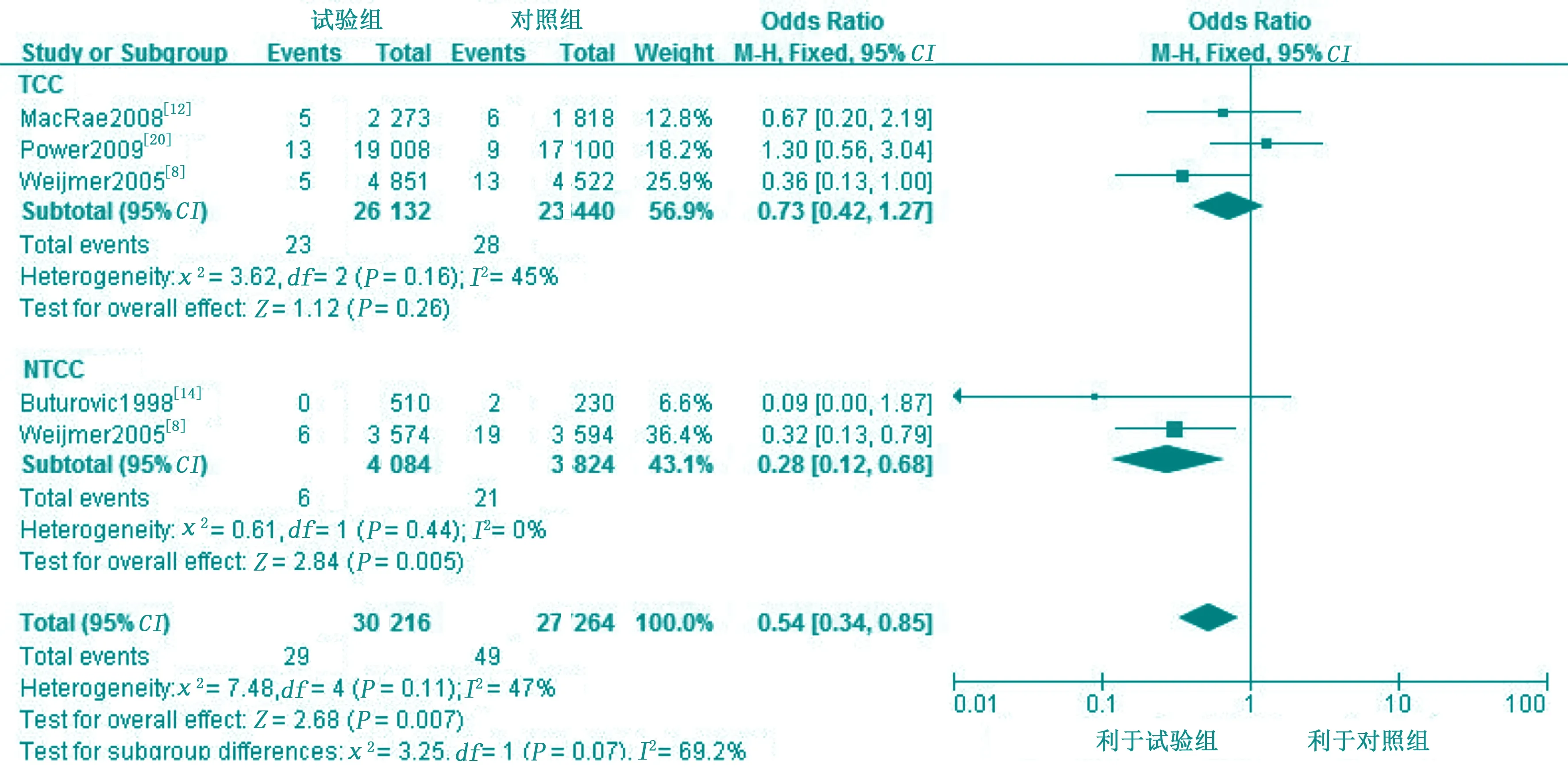
图4 ESI发生率的Meta分析

图5 ESI发生率的Meta分析
2.4 发生偏倚分析
对纳入研究不同封管方式对CRBI的发生率进行分析,结果见图6。
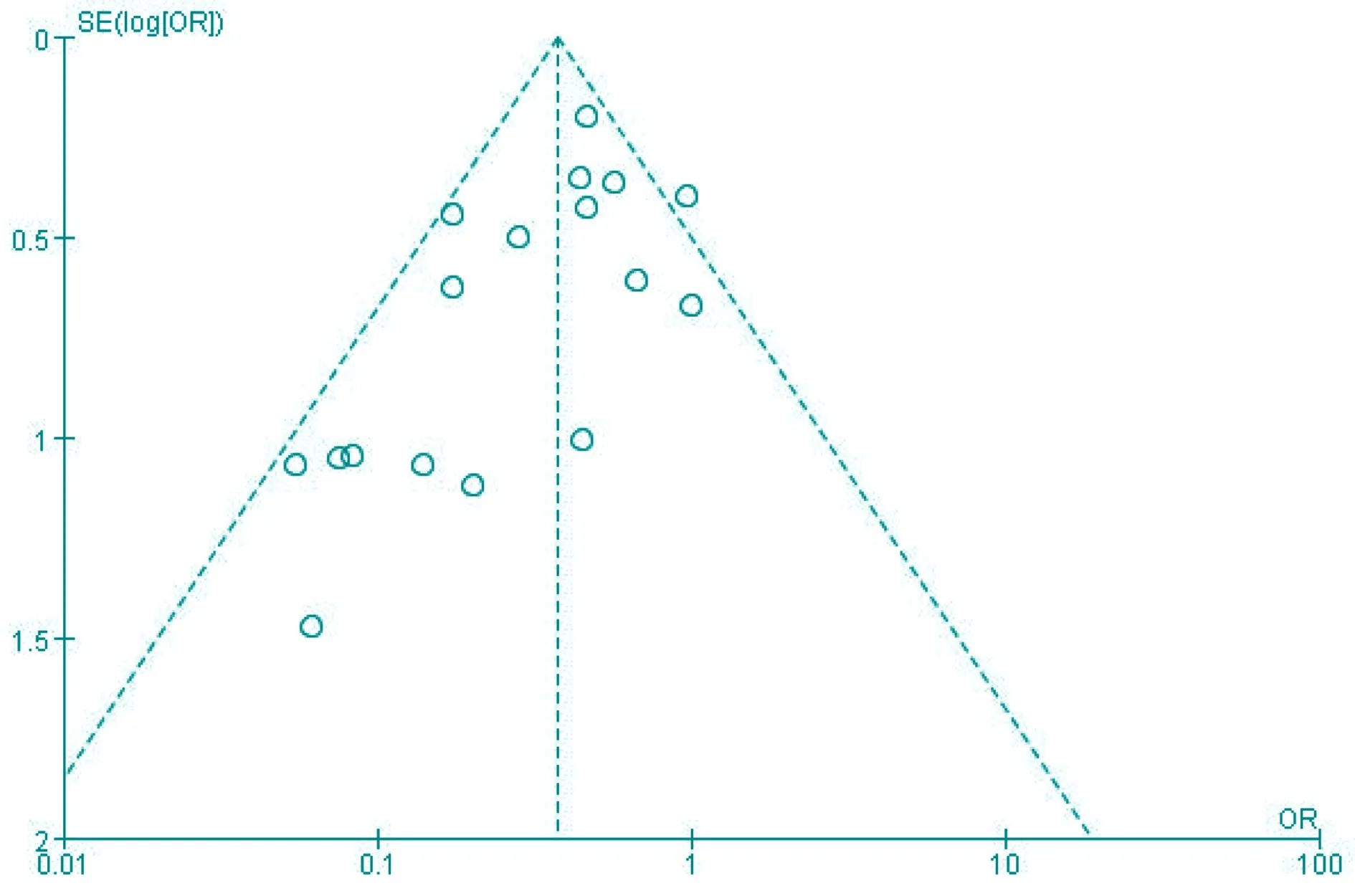
图6 CRBI发生率的漏斗图
3 讨论
尽管K/DOQI指南推荐使用自体动静脉内瘘或移植动静脉内瘘作为血液透析病人血管通路的首要选择[27],但随着老龄化和糖尿病、高血压、肥胖等疾病人数不断增加,CVC越来越广泛地应用于血液透析病人中[28]。据相关统计资料显示,全球每年新增CVC数量高达3百万~4百万[29];在美国的透析人群中,1/3的终末期病人选择长期留置导管作为他们的血液透析通路。在中国经济发达地区的血液净化中心,至少有10%以上的病人选择长期留置导管作为血管通路进行维持性血液透析治疗。然而,长期使用CVC作为血液透析血管通路,其感染及血栓形成相关功能障碍的发生率较高[30],因此,我们迫切需要探索出有效的策略,以减少CVC相关并发症发生率。使用肝素进行封管是避免CVC透析间期血栓形成的常规方法[20],但近年来,越来越多的学者指出,肝素从管腔中溢出会增加病人出血的风险[31],因此,许多新的封管方式不断涌现,如联合抗生素封管以降低CRBI的发生率及拔管率[9,32],但使用抗生素封管存在造成耐药菌产生的风险,其安全性尚未得到证实,所以目前不推荐常规预防使用[4]。枸橼酸盐是迅速代谢、不引起全身出血的碳酸氢盐[1],且具有一定的抗菌效果[33],联合抗生素封管与单纯枸橼酸盐封管可降低CRBI的发生率,这与之前的一些Meta分析结果相似[4,32,34],但单纯枸橼酸盐封管的方式却存在争议,因此,还需进一步的RCT研究证实单纯枸橼酸盐封管在预防CRBI发生率方面的作用。对于ESI的发生率,有1项RCT研究证实,枸橼酸盐封管可降低ESI的发生率[8]。然而,按照导管的不同类型进行亚组分析,发现枸橼酸盐封管并不是ESI发生的保护因素,这与之前的Meta分析结果有所不同[1]。单纯枸橼酸盐封管可以降低出血的发生风险,这与以往研究结果一致[33]。另外,也有研究报道,高浓度的枸橼酸盐(46.7%)可引起心脏骤停,因此,美国食品和药物管理局不推荐其作为导管封管液,它是否可以用于避免出血的发生也还需要大样本RCT证实。
综上所述,联合抗生素或单纯枸橼酸盐封管在降低CRBI、出血发生率方面的效果优于肝素,但其安全性还有待于进一步验证。
参考文献:
[1] Zhao Y,Li Z,Zhang L,etal.Citrate versus heparin lock for hemodialysis catheters:a systematic review and meta-analysis of randomized controlled trials[J].Am J Kidney Dis,2014,63(3):479-490.
[2] Firwana BM,Hasan R,Ferwana M,etal.Tissue plasminogen activator versus heparin for locking dialysis catheters:a systematic review[J].Avicenna J Med,2011,1(2):29-34.
[3] Safdar N,Maki DG.Use of vancomycin-containing lock or flush solutions for prevention of bloodstream infection associated with central venous access devices:a meta-analysis of prospective,randomized trials[J].Clin In-fect Dis,2006,43(4):474-484.
[4] O'grady NP,Alexander M,Dellinger EP,etal.Guidelines for the prevention of intravascular catheter-related infections[J].John Wiley & Sons,2002,52(9):e162-e193.
[5] Pettigrew M,Soltys GI,Bell RZ,etal.Tinzaparin reduces health care resource use for anticoagulation in hemodialysis[J].Hemodial Int,2011,15(2):273-279.
[6] Shah PS,Shah N.Heparin-bonded catheters for prolonging the patency of central venous catheters in children[J].Cochrane Database Syst Rev,2014,2(2):Cd005983.
[7] Grudzinski L,Quinan P,Kwok S,etal.Sodium citrate 4% locking solution for central venous dialysis catheters-an effective,more cost-efficient alternative to heparin[J].Nephrol Dial Transplant,2007,22(2):471-476.
[8] Weijmer MC,van den Dorpel MA,Van de Ven PJ,etal.Randomized,clinical trial comparison of trisodium citrate 30% and heparin as catheter-locking solution in hemodialysis patients[J].J Am Soc Nephrol,2005,16(9):2769-2777.
[9] Yahav D,Rozen-Zvi B,Gafter-Gvili A,etal.Antimicrobial lock solutions for the prevention of infections associated with intravascular catheters in patients un-dergoing hemodialysis:systematic review and meta-analysis of randomized,controlled trials[J].Clin Infect Dis,2008,47(1):83-93.
[10] Hemmelgarn BR,Moist LM,Lok CE,etal.Prevention of dialysis catheter malfunction with recombinant tissue plasminogen activator[J].N Engl J Med,2011,364(4):303-312.
[11] Higgins J,Green S.Cochrane Handbook for Systematic Reviews of Interventions Version 5.1.0[J].The Cochrane Collaboration,2011,5(2):S38.
[12] Macrae JM,Dojcinovic I,Djurdjev O,etal.Citrate 4% versus heparin and the reduction of thrombosis study (CHARTS)[J].Clin J Am Soc Nephrol,2008,3(2):369-374.
[13] Saxena AK,Panhotra BR,Sundaram DS,etal.Enhancing the survival of tunneled haemodialysis catheters using an antibiotic lock in the elderly:a randomised,double-blind clinical trial[J].Nephrology (Carlton),2006,11(4):299-305.
[14] Buturovic J,Ponikvar R,Kandus A,etal.Filling hemodialysis catheters in the interdialytic period:heparin versus citrate versus polygeline:a prospective randomized study[J].Artif Organs,1998,22(11):945-947.
[15] McIntyre CW,Hulme LJ,Taal M and Fluck RJ.Locking of tunneled hemodialysis catheters with gentamicin and heparin[J].Kidney Int,2004,66(2):801-805.
[16] Campos RP,Nascimento MM,Chula DC,etal.Minocycline-EDTA lock solution prevents catheter-related bacteremia in hemodialysis[J].J Am Soc Nephrol,2011,22(10):1939-1945.
[17] Betjes MG,Agteren M.Prevention of dialysis catheter-related sepsis with a citratetaurolidine-containing lock solution[J].Nephrol Dial Transplant,2004,19(6):1546-1551.
[18] Dogra GK,Herson H,Hutchison B,etal.Prevention of tunneled hemodialysis catheter-related infections using catheter-restricted filling with gentamicin and citrate:a randomized controlled study[J].J Am Soc Nephrol,2002,13(8):2133-2139.
[19] Kim SH,Song KI,Chang JW,etal.Prevention of uncuffed hemodialysis catheter-related bacteremia using an antibiotic lock technique:a prospective,randomized clinical trial[J].Kidney Int,2006,69(1):161-164.
[20] Power A,Duncan N,Singh SK,etal.Sodium citrate versus heparin catheter locks for cuffed central venous catheters:a single-center ran-domized controlled trial[J].Am J Kidney Dis,2009,53(6):1034-1041.
[21] Al-Hwiesh AK.Tunneled catheter-antibiotic lo-ck therapy for prevention of dialysis catheter-related infections:a single center experience[J].Saudi J Kidney Dis Transpl,2008,19(4):593-602.
[22] Maki DG,Ash SR,Winger RK,etal.A novel antimicrobial and antithrombotic lock solution for hemodialysis catheters:a multicenter,controlled,randomized trial[J].Crit Care Med,2011,39(4):613-620.
[23] Solomon LR,Cheesbrough JS,Ebah L,etal.A randomized double-blind controlled trial of taurolidinecitrate catheter locks for the prevention of bacteremia in patients treated with hemodialysis[J].Am J Kidney Dis,2010,55(6):1060-1068.
[24] Moran J,Sun S,Khababa I,etal.A randomized trial comparing gentamicin/citrate and heparin locks for cen-tral venous catheters in maintenance hemodialysis patients[J].Am J Kidney Dis,2012,59(1):102-107.
[25] Nori US,Manoharan A,Yee J and Besarab A.Comparison of low-dose gentamicin with minocycline as catheter lock solutions in the pre-vention of catheter-related bacteremia[J].Am J Kidney Dis,2006,48(4):596-605.
[26] Sofroniadou S,Revela I,Smirloglou D,etal.Linezolid versus vancomycin antibiotic lock solution for the preven-tion of nontunneled catheter-related blood stream infections in hemodialysis patients:a prospective randomized study[J].Semin Dial,2012,25(3):344-350.
[27] National Kidney Foundation.K/DOQI Clinical Practice Guidelines for Vascular Access[J].Am J Kidney Dis,2006,48(suppl 1):S176-S322.
[28] Mandolfo S,Acconcia P,Bucci R,etal.Hemodialysis tunneled central venous catheters:five-year outcome analysis[J].J Vasc Access,2014,15(6):461-465.
[29] Causes of deaht:USRDS:United States Renal Data System[J].AmJ KidneyDis,1997,30(2Suppl ):5107-511.
[30] Van Der Meersch H,De BD,Vandecasteele SJ,etal.Catheter Design and Catheter Performance:A Randomized Controlled Trial[J].Am J Kidney Dis,2014,64(6):902-908.
[31] Mandolfo S.Central venous catheter lock to prevent thrombosis and bacterial infection[J].G Ital Nefrol,2012,29(3):301-307.
[32] Snaterse M,Ruger W,Lucas C,etal.Antibiotic-based catheter lock solutions for prevention of catheter-related bloodstream infection:a systematic review of randomised controlled trials[J].J Hosp Infect,2010,75(1):1-11.
[33] Pierce DA,Rocco MV.Trisodium citrate:an al-ternative to unfractionated heparin for hemodialysis catheter dwells[J].Pharmacotherapy,2010,30(11):1150-1158.
[34] Moore CL,Besarab A,Ajluni M,etal.Comparative effectiveness of two catheter locking solutions to reduce catheter-related bloodstream infection in hemodialysis patients[J].Clin J Am Soc Nephrol,2014,9(7):1232-1239.



